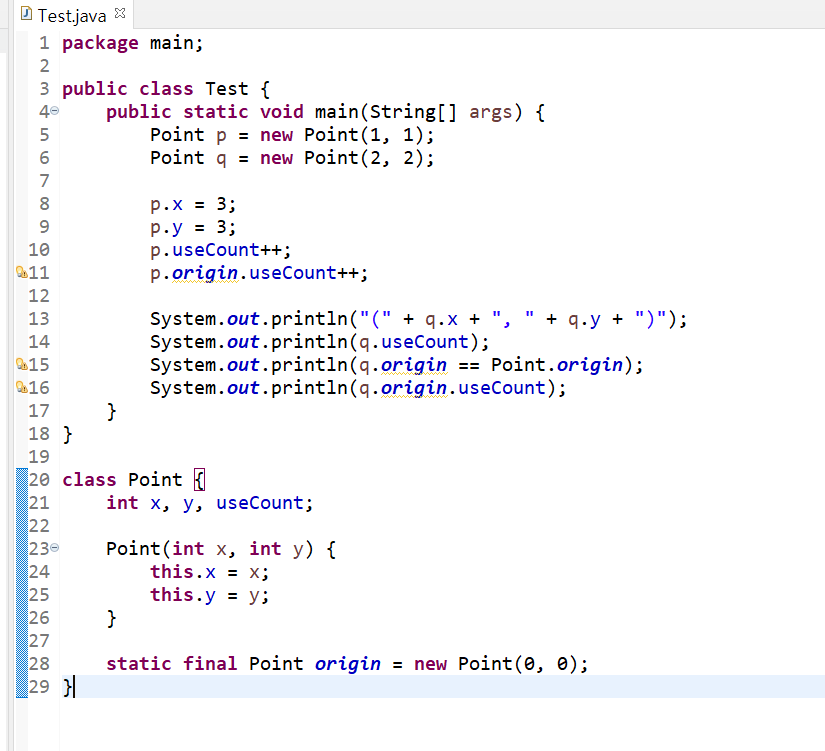8.3.1 Field Modifiers
8.3.1.1 static Fields

결과:
(2, 2)
0
true
1
Example 8.3.1.1-2. Hiding of Class Variables
package main;
public class Test extends Point {
static double x = 4.7;
public static void main(String[] args) {
new Test().printX();
}
void printX() {
System.out.println(x + " " + super.x);
}
}
class Point {
static int x = 2;
}결과:
4.7 2Test 클래스의 x의 선언은 Point 클래스의 x의 정의를 숨기기 때문에,
Test 클래스는 그것의 슈퍼클래스인 Point 클래스의 x를 상속받지 않는다.
package main;
public class Test extends Point {
public static void main(String[] args) {
new Test().printX();
}
void printX() {
System.out.println(x + " " + super.x);
}
}
class Point {
static int x = 2;
}결과:
2 2
Example 8.3.1.1-3. Hiding of Instance Variables
package main;
public class Test extends Point {
double x = 4.7;
void printBoth() {
System.out.println(x + " " + super.x);
}
public static void main(String[] args) {
Test sample = new Test();
sample.printBoth();
System.out.println(sample.x + " " + ((Point)sample).x);
}
}
class Point {
int x = 2;
}결과:
4.7 2
4.7 2
8.3.1.2 final Fields
8.3.1.3 transient Fields
8.3.1.4 volatile Fields
The java programming language allows threads to access shared variables.
As a rule, to ensure that shared variables are consistency and reliably updated,
a thread should ensure that it has exclusive use of such variables by obtaining a lock that, conventionally, enforces mutual exclusion for those shared variables.
The java programming language provides a second mechanism, volatile fields,
that is more convenient than locking for some purposes.
A field may be declared volatile, in which case the Java Memory Model ensures that all threads see a consistent value for the vaiable.
It is a compile-time error if a final variable is also declared volatile.
Example 8.3.1.4-1. volatile Fields
If, in the following example, one thread repeatedly calls the method one(but no more than Integer.MAX_VALUE time in all), and another thread repeatedly calls the method two:
package main;
public class Test {
static int i = 0, j = 0;
static void one() {
i++;
j++;
}
static void two() {
System.out.println("i = " + i + " j = " + j);
}
}then method two could occasionally print a value for j that is greater than the value of i,
because the example includes no synchronization and, under the rules explained in $17.4,
the shared values of i and j might be updated out of order.
One way to prevent this out-or-order behavior would be to declare methods one and two to be synchronized($8.4.3.6):
package main;
public class Test {
static int i = 0, j = 0;
static synchronized void one() {
i++;
j++;
}
static synchronized void two() {
System.out.println("i = " + i + " j = " + j);
}
}This prevents method one and method two from being executed concurrently, and furthermore guarantees that the shared values of i and j are both updated before method one returns.
Therefore method two never observes a value for j greater than that for i;
indeed, it always observes the same value for i and j.
Another approach would be to declare i and j to be volatile:
package main;
public class Test {
static volatile int i = 0, j = 0;
static void one() {
i++;
j++;
}
static void two() {
System.out.println("i = " + i + " j = " + j);
}
}This allows method one and method two to be executed conccurently, but guarantees that accesses to the shared values for i and j occur exactly as many times, and in exactly the same order, as they appear to occur during execution of the program text by each thread.
'자바' 카테고리의 다른 글
| [스레드] 2. 작업 스레드 생성과 실행 - 1 (0) | 2021.12.29 |
|---|---|
| [스레드] 1. 멀티 스레드 개념 (0) | 2021.12.29 |
| 8.3 Field Declarations (1) (0) | 2021.10.11 |
| [자바] 8.2 클래스 멤버 (0) | 2021.10.02 |
| 람다 표현식과 this 키워드에 관하여 (0) | 2021.09.26 |
